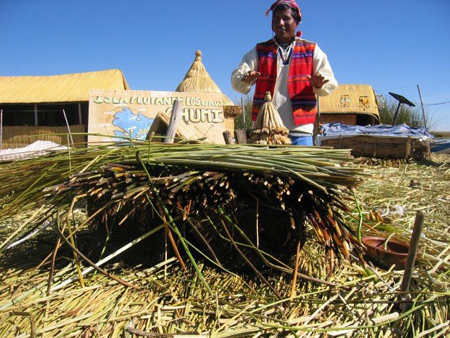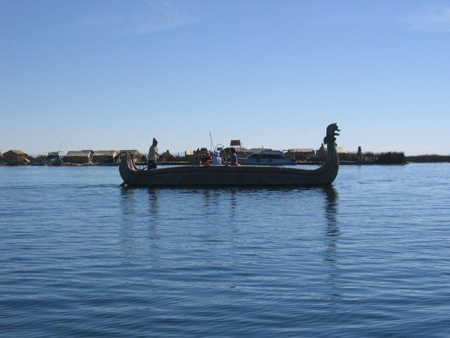
This Island Earth
A city that floats
by Kate Meyer

Somewhere just beyond the northwestern shores of Lake Titicaca, high in the Andean cordillera of Peru, there is a city floating. It lies beyond the slowly rippling waters that are coated with a mealy film of algae hugging the coast, out where the thickets of totora reeds rising up through the lake’s glassy surface grow denser. Out there, excluded from the graces of Puno's coastal purview there floats a city, or rather, a collective of islets inextricably bound to each other economically, culturally and historically, if not physically. The inhabitants of these man-made islands are Uros, a people now greater in number on land than lake. There have been deserters, but those who remain hold still to tradition, preserving the allure of a fledgling society that dared to exist on such capricious turf. When the Uros forged the islas flotantes 500 years ago, it was to seek refuge from invading Spanish colonizers. Now, the fluidity at the heart of the islands' conceit provides solution to more internecine disagreements - they say, if you don't like your neighbors, you can literally cut the ties that bind and float away in the night. Similarly, if a resident is slacking off on his share of the work, he may awake one morning to find that sometimes, John Donne be damned, one man is an island. The land itself appears modest, belying the curiosity of its concept. Each island rises maybe 18 inches off the water, and appears to be covered in straw — it is the totora reed, the marrow of Uros society. Dried, it is used as material for fishing boats, houses, and artisanal crafts sold to tourists, who now compose the backbone of the Uros economy. Fresh, the totora is used for food and flooring.

Beginning with a sturdy floating bog, and then laying a base of totora reeds over it, the men, women and children of Uros work together, piling the reeds in a different direction every two weeks until they have created a latticework strong enough to hold six or seven homes and one kitchen on each island, a process that takes about eight months. All of the forty-odd islands are then anchored to sticks pitched into the lake's floor, making the community buoyant but stationary. Though the islands at conception are about three to four feet thick, they will double over time as dying reeds are covered with newer, stiffer ones, a process of renewal repeated until it is time to build an entirely new island. This isochronal task is performed nearly every eight years, so that in one man's lifetime he may have lived on more than half a dozen different islands while staying in the same 100-ft radius.

It is a cyclical, sustaining system that offers the comforting paradox of revolution steeped in tradition. Somewhere out beyond the pesto-like crust of Lake Titicaca's shore, there floats a city. It is a city bobbing softly on the still waters of its ancestry, where its people live with the pinching evanescence and the quiet promise that if they walk on the same ground long enough, one day it will be new.



